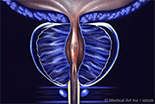Don't put off prostate examinations

When the prostate causes problems, men often keep quiet or joke about it instead of going to the doctor. But that can be life threatening. A checkup, in contrast, is far less dire than many fear.
It is perhaps the most masculine organ of all. The prostate and seminal vesicle generate most of the ejaculate and are thus of central importance for sexuality and fertility. But this roughly chestnut-sized gland beneath the bladder is also responsible for most male cancers. Nearly 60,000 men in Germany develop it every year. Prof. Dr. Christian Gratzke, Medical Director of the Department of Urology at the Medical Center - University of Freiburg, explains how pathological changes are detected, whether a prostate examination is unpleasant, and how prostate removal changes having sex.
Professor Gratzke, how does prostate cancer manifest?
A malignant enlargement of the prostate - i.e. prostate cancer - causes few or no symptoms for a long time. Only later can it cause blood in the urine, difficulties urinating, pain while ejaculating and/or potency disorders. Yet if it is detected early, the cancer can usually be successfully treated. Therefore, check-ups are recommended from the age of 45.
Many men are afraid that the check-up is quite unpleasant. Is that true?
Unfortunately, this misconception is widespread. After the examination, most men tell us that it was far less dire than they feared. First, talking to the patient, we clarify whether pre-existing conditions, current symptoms or hereditary risk for prostate disease exist. The tactile examination with the finger takes only about 30 seconds. Hardly any other type of cancer has such a simple, low-side-effect screening examination.
The Prostate Specific Antigen (PSA) level is often determined too. Does this make sense?
Determining the PSA level in the blood is still useful today, and is standard in check-ups. It is important to interpret the PSA value meaningfully. Not just the absolute level, but above all the change compared to the previous value is important. A PSA increase is not always a sign of prostate cancer; it can also for example be elevated due to prostate inflammation.
How is it determined if it really is cancer, and how big it is?
High-precision imaging such as MRI, CT and PSMA PET/CT is now routine at the Medical Center - University of Freiburg. The PSMA PET/CT technique in particular helps us, because with it we can recognize even tiny cancerous deposits, based on the altered body metabolism. This precise diagnosis allows us to tailor treatment individually to the patients. A robot-assisted image-guided biopsy procedure helps us to accurately take samples from suspected prostate tissue. The procedure is very exact and gentle on the patients.
How do you treat prostate cancer?
The treatment depends strongly on the tumor stage. Surgery and radiation are the standard procedures for localized prostate cancer. Especially for these patients, robot-controlled minimally invasive radical prostatectomy has been developed. This has also been offered since December 2018 at the Medical Center - University of Freiburg. But for this it is important that the cancer is detected early.
Does an enlarged prostate always mean cancer?
No, each man's prostate grows as he ages. So to start with, an enlargement is not unusual. But even benign growth can have unpleasant consequences, such as those affected having to urinate more often. Nocturnal urination is particularly unpleasant. The treatment of benign prostate enlargements is also constantly evolving.
Are there any new treatments that you offer to your patients?
For many years, one of my priorities has been minimally invasive treatment of patients with benign prostate enlargement. In Freiburg we offer the full range of techniques that are currently on the market. This includes more than just transurethral enucleation of the prostate using the holmium laser (HoLEP), which has been established for years at the Medical Center - University of Freiburg and is offered with high expertise. Other minimally invasive techniques, such as the Urolift procedure, the iTIND technique or the Rezum procedure, are used in selected patients. In the future, ablation with a water jet ("aquablation") will also be offered. Here, however, keeping the patients well-informed about the advantages and disadvantages of each procedure is crucial. We are also interested in testing new techniques in studies, then being able in the medium term to offer them as part of our standard routine.
Back